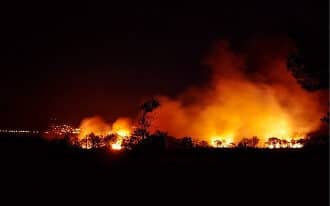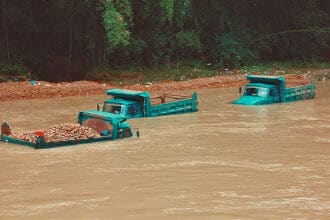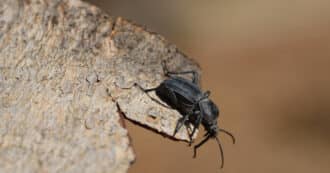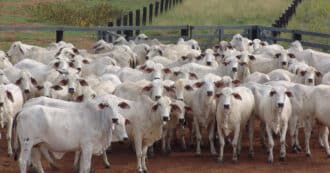By Harry Cooper
It is estimated that 30% of our world is covered in forests. These forests are home to thousands of species, harbor many different ecosystems, and support countless people.
But despite all the wonderful things forests give us, they are at a risk of disappearing. This could destroy some of the most lively and lush places on Earth.
Destroying Our Forests
If we were to lose our forests we would be harming hundreds of plants, animals, and humans by contributing to climate change, destroying biodiversity, and taking away many people’s source of income and livelihood. Many of the plants in amazon rainforests have medicinal properties that only slowly are being discovered. One of the consequences of deforestation is the loss of healing plants for some of humanity’s major diseases. It is of the utmost importance that we work to protect forests from encroaching deforestation before it is too late.
Deforestation Statistics
At the beginning of the 2010s the Earth lost around 12 million hectares of forest every year. While this has decreased to 10 million hectares of forest lost each year since 2015, with millions of trees cut down every year, these are incredibly alarming statistics, despite the slow decrease.
Another important thing to understand about global deforestation is that it does not happen evenly across the world. Deforestation occurs most severely in tropical forests in countries such as Brazil, the Democratic Republic of the Congo, Indonesia, and Angola.
Deforestation is particularly harmful in these countries not only because so much biodiversity is lost due to tropical deforestation, but people in developing countries are more vulnerable to the adverse affects of deforestation and are also more exposed to it.
Why Is Deforestation SO Bad?
Humans have been cutting down trees for almost our entire history. But as populations grow, so does our demand for supplies and materials, causing an exponential need for more trees to be cut down.
Deforestation doesn’t happen for one specific reason. Forest cover can be cut down to clear land for the development of roads and cities, for wood extraction through logging, for agricultural and palm oil plantations.
All of these reasons for forest destruction are driven by the desire for economic growth. But with industrialization occurring at such a fast rate, it may come at the cost of losing the world’s forests.
The Impacts of Deforestation
The effects of deforestation are undeniable. Forests play such a critical role in our planet’s ecosystems, our climate, and our well being. Without them we will face serious consequences.
Global Warming
Trees play a very important role in regulating greenhouse gas emissions from fossil fuels. Trees are able to take carbon dioxide out of the atmosphere during photosynthesis and store it. These carbon stores have traditionally kept large amounts of greenhouse gases out of the atmosphere, but that has started to change with increasing deforestation.
When trees are cut down they release the carbon stored in their massive bodies. It is estimated that with current deforestation rates, the forests of the world are now releasing more carbon than they are taking in, making them sources of carbon emissions rather than stores of them.
Forest Fires
Climate change can also be a cause of deforestation. Global warming has been known to cause an increase in natural disasters, such as drought. An increase in global droughts has also led to more wildfires occurring, which in turn cause more deforestation.
Biodiversity Loss
Forests are home to many different species, providing a habitat that is rich with food, water, and shelter. It is estimated that 80% of all animals and plant species that live on land rely on forests for their habitat. This makes forests incredibly important for maintaining biodiversity.
With the amount of forested land lost to deforestation, habitat loss has been occurring on an unprecedented scale. It is estimated that anywhere from 4,ooo to 6,000 forest dwelling species go extinct every year as result of deforestation. If we want to protect the ecosystems and habitats of our world, it is critical that we find a solution to deforestation.
The Impacts on Local Populations
Some of the people who are most affected by deforestation are the people who live near forests. These people that are often apart of vulnerable or indigenous communities can find themselves without a home, and without their livelihood. Many people are completely forced out of their homes due to deforestation, but those who are able to stay still face the consequences of deforestation.
As animals lose their habitat, they are likely to wander to find new places to live which leads to more interactions between humans and wild animals. These interactions can be dangerous in more ways than one.
While an animal might not necessarily attack a human it comes into contact with, it does increase the spread of zoonotic diseases. Zoonotic diseases are diseases that are spread through animals, such as malaria, Ebola, and even COVID-19, which is thought to have been caused by human interaction with animals.
Many people also rely directly on forests for food, clean water, and jobs. When forests get torn down it can destroy people’s entire source of living, and lead to food insecurity and increased poverty rates. Thus deforestation is not just important for protecting the environment, but for protecting the lives of people everywhere.
Soil Erosion
Forests are also key to making sure that that the water cycle operates properly. Tree roots are capable of keeping soil in place when it rains which helps the ground retain its structure.
When trees start disappearing due to deforestation soil becomes looser and can erode much more easily. Erosion can restructure the landscape as well as take nutrients out of the top soil. Without the nutrients soils become much less fertile, and it becomes much harder for things to grow there.
Along with this, deforestation leads to conditions that are more suitable for flooding. Not only are there less trees to absorb the water, but less dense soil won’t stay in place as well, making it easier for floods to occur.
Deforestation and Religion
Exodus 33:3 – a Land Flowing with Milk and Honey. But I Will Not Go in Your Midst, Since You Are a Stiff-Necked People, Lest I Destroy You on the Way.
Grazing and Sustainability From the Eco Bible
The Torah often describes the Land of Israel as “a land flowing with milk and honey.” The Talmud interprets this to mean: “milk flows from the goats [udders], and honey flows from the dates and the figs.” From this, one can understand the significance of goats and shepherding to ancient Israel’s society.
Some herders would take their flocks to graze for six months at a time, between Passover and the beginning of winter, while others would keep their flocks in pasture year-round. Professor Gedaliah Alon, in his noted history of Mishnaic and Talmudic times, writes that some herders raised flocks of sheep and goats in great numbers. Yet goats and sheep are voracious herbivores, and the rabbis in the times of the Mishnah and Talmud witnessed how these animals could devour field crops.
In response, the Mishnah prohibited raising goats and sheep in agriculturally productive parts of Israel. This enactment was likewise adopted by the rabbis in Babylonia for the Jewish community there, which in the times of the Talmud replaced Israel as the most sizable Jewish community in the world. Further, the Talmud prohibited freely grazing oxen and cows as well.
From the patriarchs and the tribes of Israel, to Moses and King David, the Bible is replete with a rich history of shepherding and livestock raising. Nevertheless, the Mishnaic decree addressed the need to stop goats from harming farmers’ crops by preventing Jews from raising them in settled parts of Israel. If the rabbis were prepared to contravene thousands of years of Biblical tradition by forbidding herding, this should serve as a lesson to contemporary humankind about the need to limit the raising of livestock in massive numbers, when we are aware of the environmental damage that this causes.
As Yale’s Global Forest Atlas notes, “Cattle ranching is the largest driver of deforestation in every Amazon country, accounting for 80 percent of current deforestation rates. Amazon Brazil is home to approximately 200 million head of cattle, and is the largest exporter in the world, supplying about one-quarter of the global market. Approximately 280,000 square miles (450,000 square kilometers) of deforested Amazon in Brazil are now in cattle pasture.”
In the coronavirus pandemic of 2019–20, a new disease infected people in Wuhan, China, before rapidly spreading across the globe. Contemporary scientists are beginning to see a connection between such pandemics and human impacts on the environment. When humans cut down forests and destroy the habitat of animals, the surviving animals move to new territories where they encounter new diseases, some of which may be transferred to humans. For example, 27 outbreaks of the Ebola virus were found to have a strong association with nearby cutting down of forests. Close to 75 percent of all emerging infectious diseases have jumped from an animal to a human, according to researchers. When people destroy ecosystems, pathogens like viruses that emerge from nature have fewer and fewer non-humans to infect. In the interconnected earth on which we live, deforesting the world’s rainforests can have unforeseen and major consequences.
* Featured image source








